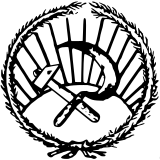Communist Workers' Party of the Netherlands Kommunistische Arbeiders-Partij Nederland | |
|---|---|
| Abbreviation | KAPN |
| Leader | Herman Gorter |
| Founded | 1921 |
| Dissolved | c. 1933 |
| Split from | Communist Party of the Netherlands |
| Ideology | Council communism |
| Political position | Far-left |
| International affiliation | Communist Workers' International |
| Part of a series on |
| Left communism |
|---|
 |
The Communist Workers' Party of the Netherlands (Dutch : Kommunistische Arbeiders-Partij Nederland) was a council communist party in the Netherlands. It was founded in September 1921, and was modelled after the Communist Workers' Party of Germany. It was far smaller than its German counterpart. At most, in late 1921, it had 8 sections with a total membership of around 200. Herman Gorter played an important role in building the party. [1] The party was affiliated to the Communist Workers' International. [2]
Contents
The membership of the party decreased rapidly as the party was engulfed in internal conflicts. [3]